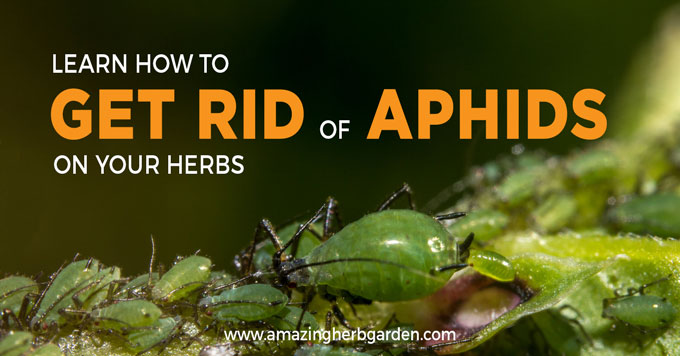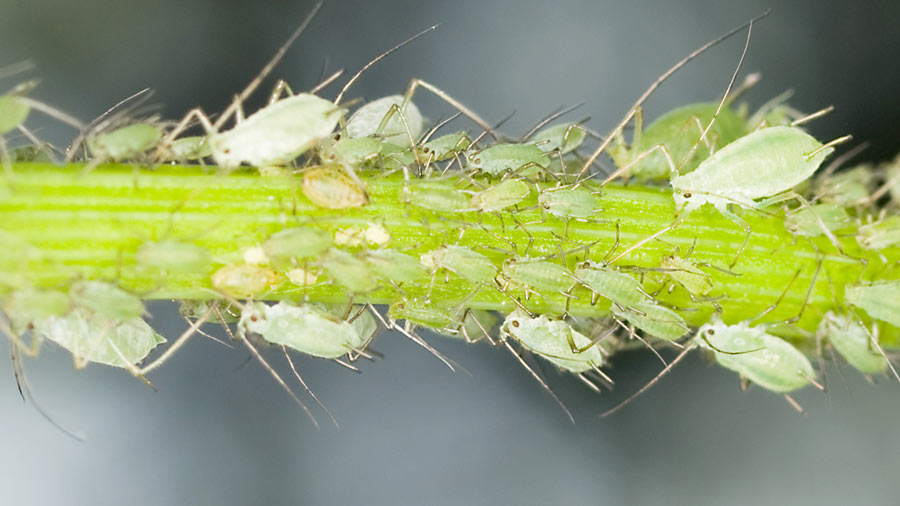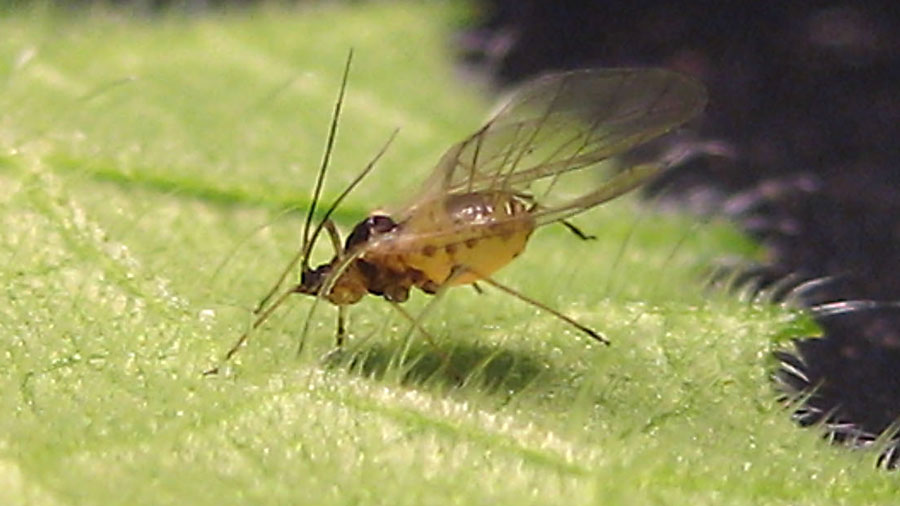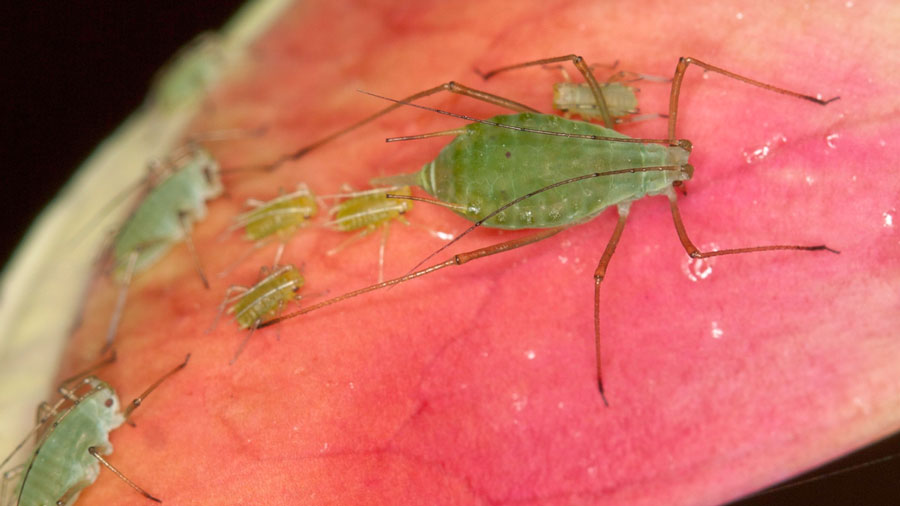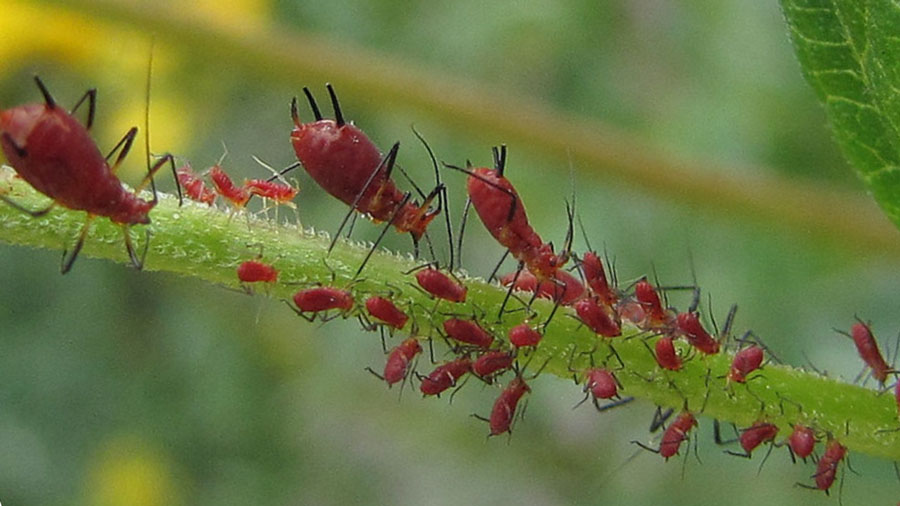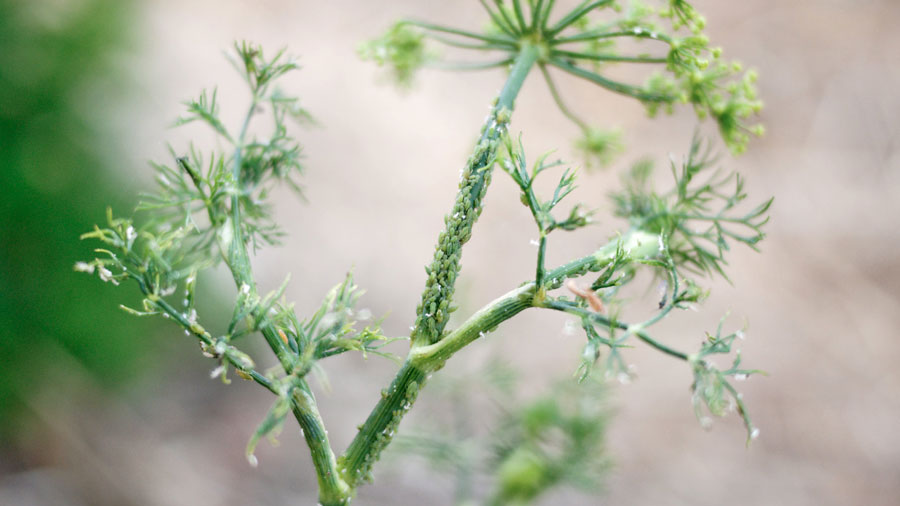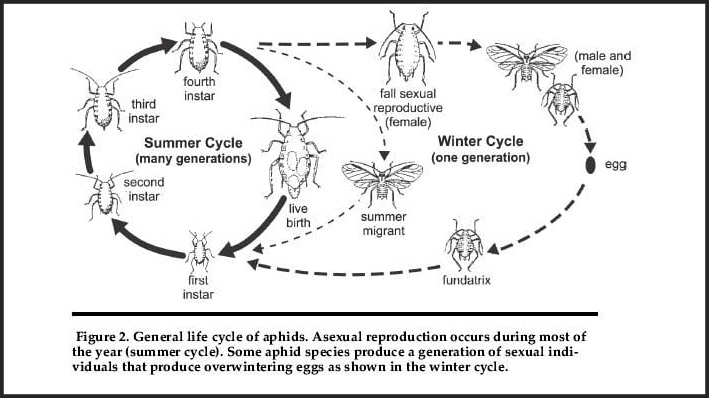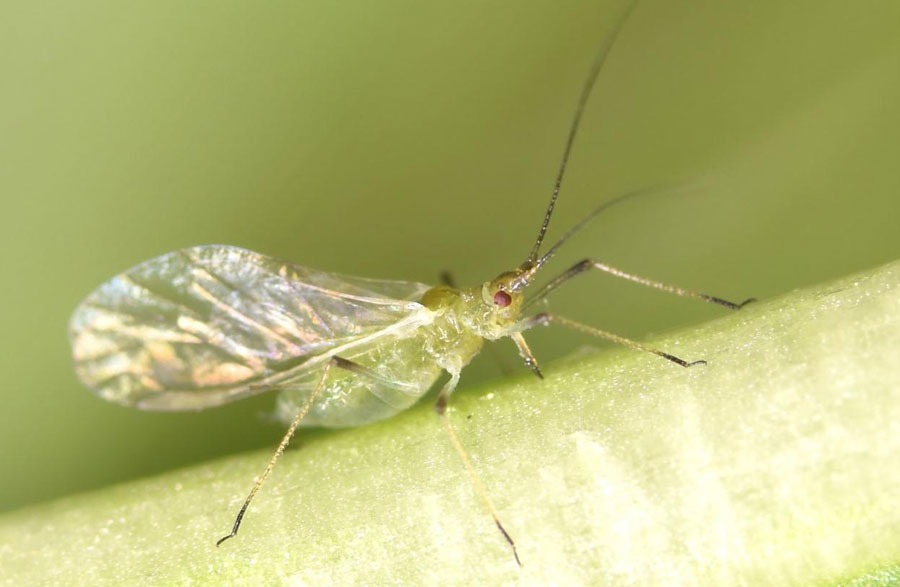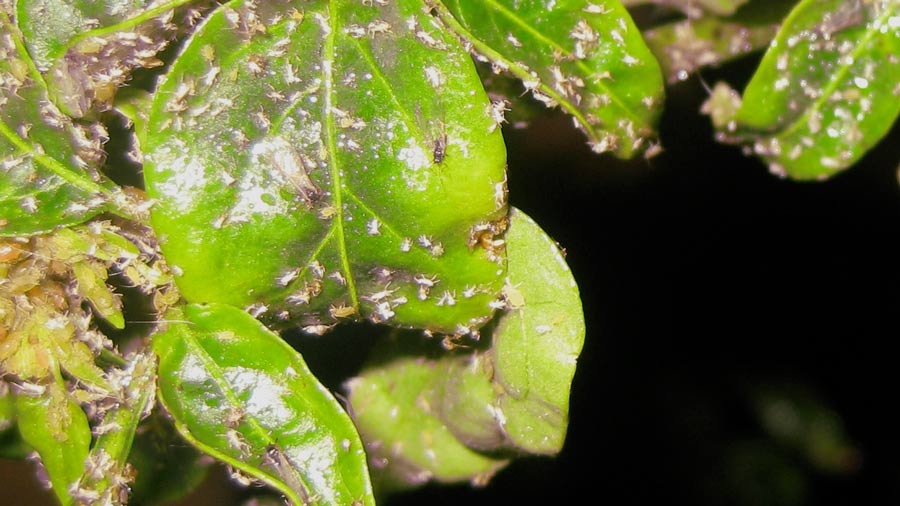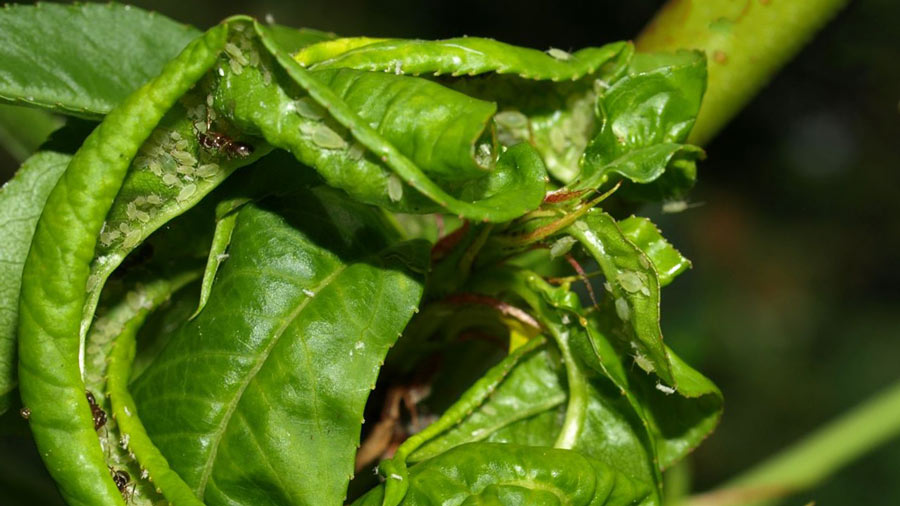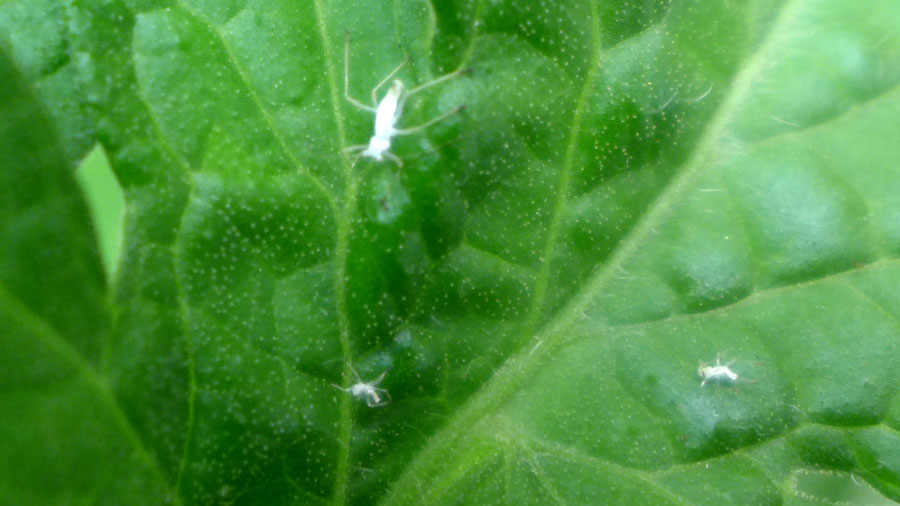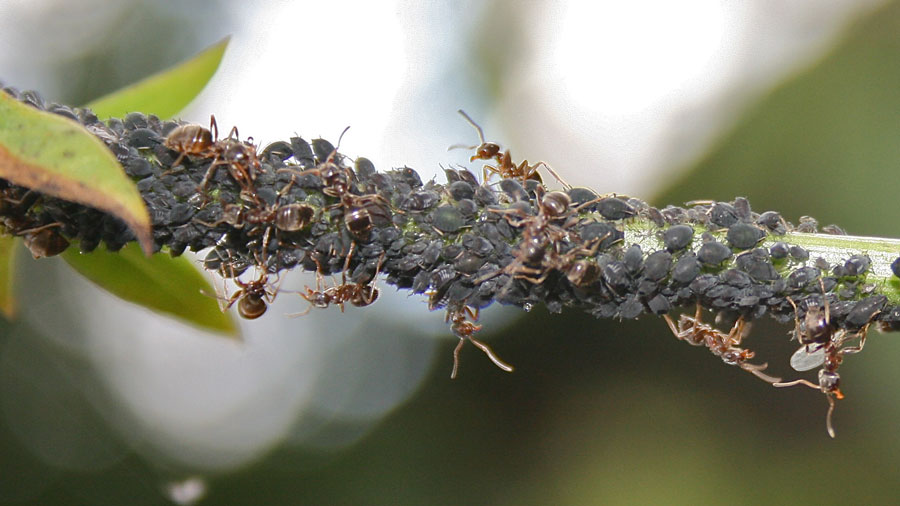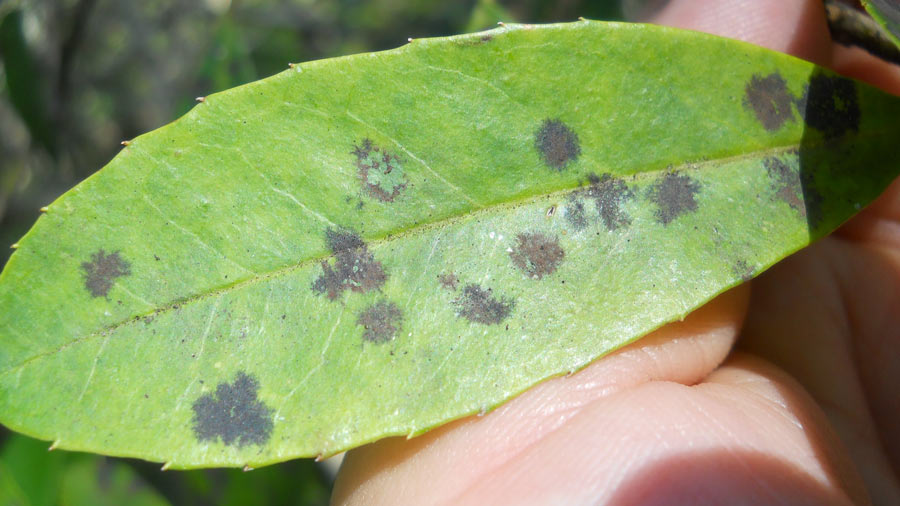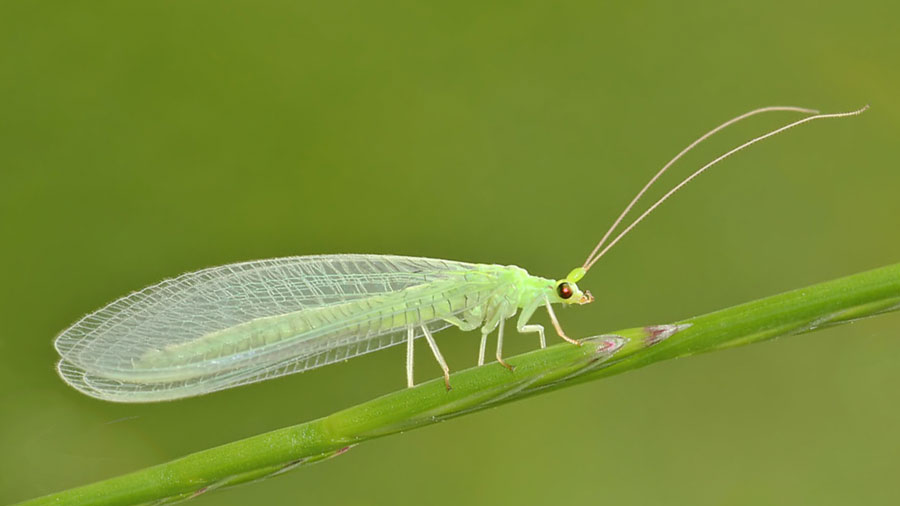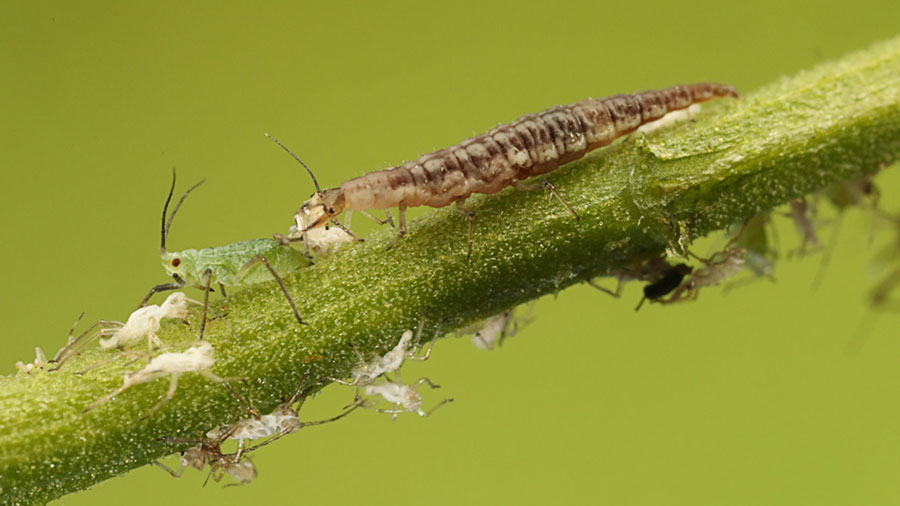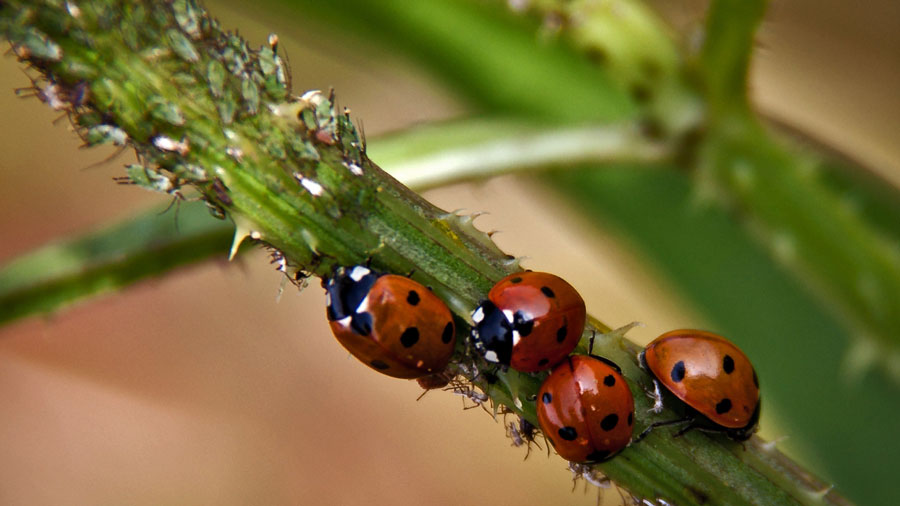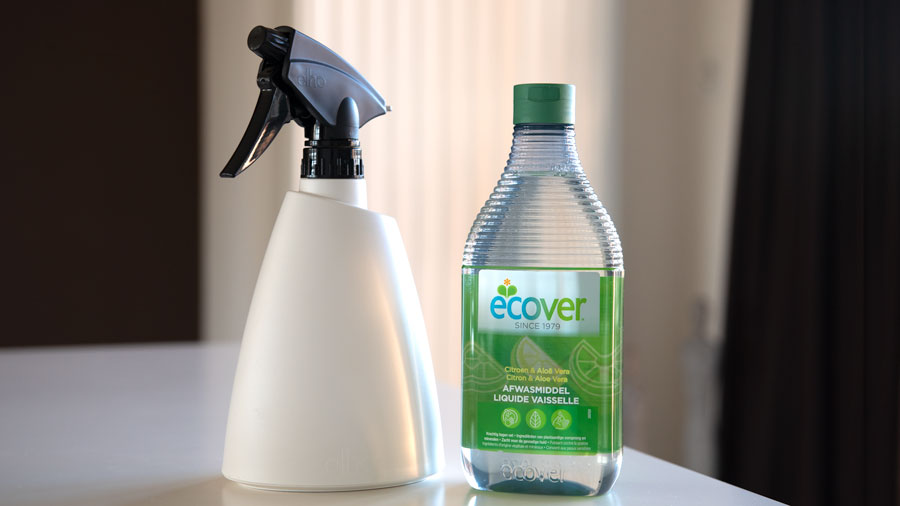HOW TO GET RID OF APHIDS in our HERB GARDEN
In this article I want to share what I have learned and what every herb gardener should know about aphids and more specific how to get rid of aphids in the herb garden.
Content
1. Definition of aphids – What are aphids?
2. How to prevent aphids get on your plants in the first place?
– The prolific lifecycle of aphids
– How do aphids get on indoor plants?
3. How to check your plants and herbs for aphids?
– What are the symptoms of aphids?
4. Aphids on herbs? How to get rid of aphids on your indoor plants?
– Natural enemies
– Other possible ways to get rid of aphids
– My home-made spray to kill aphids
1. Definition of aphids – What are aphids?
Aphids are very small sap-sucking bugs or insects that feed on the sap of plants. There are more than a thousand sorts of aphids, also called plant lice, all members of the happy sap-sucker family Aphidoidea.
Most of the aphids are small and tiny, about 3 to 6 mm in size, with often oval or pear-shaped bodies. They come in a large variety of colors too (green, light green, white, brown, red, gray, black and even pink).
Aphids are rather common spread insects that can be found on all sorts of plants. The aphids suck sap from plants by using their long beak which functions like a straw. Plants need sap to distribute nutrients, so losing sap will actually harm the plants.
There are aphids that will feed on only one or two plant species. But other aphids are not so picky and they will feed on a wide variety of plants, including vegetables, fruits, herbs and houseplants.
As already mentioned aphids feed themselves by sucking sap from plants. The problem with aphids is that they like to live in large colonies and that they reproduce very fast. This combination can cause very extensive damage to plants if we leave them alone to feed on our plants and expand.
This results often in dying plants if no action is taken.
Aphids breed very quickly, often without mating. This means that even a small group of sap-sucking aphids, that remained untreated, can repopulate a colony very fast.
Depending on the sort, aphids spread by walking or flying, which makes controlling aphids even more difficult.
Aphids are also known to spread plant diseases as they move from one plant to another.
As you can imagine, the consequences of aphids on a plant can be disastrous: distorted growth, low survivability, dying leaves and stems with finally death of the plant.
Very often we don’t even suspect to have aphids on our plants, until we notice the plant or herb is not doing very well.
So we need to keep an eye out for them to detect aphids as soon as possible and to take the necessary actions to get rid of aphids.
2. How to prevent aphids get on your plants in the first place?
Let’s break this chapter down in two parts:
First, let’s take a look at the life cycle of aphids. Next, we will try to determine how aphids get on our indoor plants in the first place.
Both topics are important to understand, in order to prevent aphids on your herbs.
The prolific lifecycle of aphids
In order to have an idea about how we can get rid of aphids get on our herbs, we need to need to understand the life cycle of aphids.
Aphid’s life cycle is rather complicated. Let me state that the rapid asexual reproduction of aphids is fast and exponential which leads to widespread infestation.
As so often with insects, there are many kinds of aphids. Each of the many aphid species has its own life cycle, but there are some features common to nearly all of them:
- female aphid species can reproduce without mating, in a process known technically as parthenogenesis.
- most aphid species can grow wings at specific moments in their lifes
- aphids can transform in either males or females
One feature most species share is that they are incredibly productive.
Let’s describe the life cycle of an aphid:
When an egg, usually attached to a plant, hatches in spring, it produces a wingless female aphid.
Very soon after hatching, the newborn wingless females begin to parthenogenetically reproduce. This means that they will excrete new young living female offspring multiple times a day.
This fast reproduction and multiplication in numbers will continue generation after generation, until the weather gets warmer.
When the plant on which they are living starts to die – because all the hungry off-spring is hungry and is sucking the sap of the plant – it happens that suddenly some females grow wings and fly off to find a new plant host, that can be of different species than the previous one.
Later in the year, when summer is over and it is time to move back to the plant species on which the aphid typically overwinters, some aphids develop into males.
A sexual reproduction between males and females takes place and after mating the females return to the winter plant. On the winter plant, the females will lay their fertilised eggs on the leaves and openings of the plant.
Next spring, new fresh females hatch from the eggs and the cycle begins again, initially with no males in sight.
Now we have an idea about the life cycle, let’s talk about numbers.
During the parthenogenetically process, instead of laying eggs, the wingless females will excrete young living female offspring up to 100 times a day.
A newly born aphid becomes a reproducing mother within 7 days and they, at their turn, can produce up to 5 offspring per day for up to 30 days! With each new female reproducing, you can see how quickly populations can build-up, appearing almost like magic.
One aphid can have millions of descendants in one season.
And all this offspring is hungry…
Luckily in nature, this rapid reproduction is kept in check by natural enemies such as ladybird beetles, lacewings, bugs and many others.
How do aphids get on indoor plants?
There are a couple of ways I can think of on how aphids find their way on my indoor plants.
Let me remind you that aphids spread asexual reproduction, by laying eggs on plants and by migration via wings.
Firstly, some aphid species can fly so there is a chance that aphids can get indoors through an open window or an open door… crazy isn’t it? So flight is one method how they spread.
If you have a window open frequently in summer where there are a lot of plants just outside of the window, that may be a source of aphids too, especially when you have plants on the windowsill.
The second possibility is that aphids are carried inside, for example via cloths or pets.
Kids playing outside in the garden, or making a walk with the dog are very good opportunities where contact close to outside plants can get aphids on clothing or fur.
This way they may bring aphids in unintentionally.
And thirdly, in my opinion the possibility with the highest probability: it is very likely that aphids were already on the plants, cuttings or maybe even soils when you brought inside the house. Aphids can enter your home when you bring in a plant that contains aphid eggs on the leaves or in the soil.
Aphids are a real pain for our plants. Besides being highly effective in adapting, spreading and reproduction, aphids are also masters in hibernating during winter, under egg form on a plant or in the soil or even as a baby aphid (nymphs).
When we know all this we realize that it is basically impossible to avoid aphids 100% of the time. That is why I think that understanding how they live and reproduce, will allow us to fight them and prevent future infestations.
3. How to check your plants and herbs for aphids?
Lots of aphids have camouflaging colours, making them hard to detect, especially when their favourite hobby is hiding under the leaves, sucking sap from young and tender new growth.
Aphids are very small and also very good in hiding. This makes that usually we will miss them if we are not looking out for them. But it goes without saying that good aphid control is essential for the survival of our beloved herbs and plants.
Aphids are usually sucking on the nerves of the leaves and on the stems of the plant to get all the juicy sap out of the plant. Once they stick their needle-like mouthparts (some call it their pin shaped suck-mouth or their straw-like beaks) into the plant they become stationary for a while, and they will be easier to spot.
It is even easier to use a 10x magnifier, to take a good look at these suckers and to identify them.
So this means, because aphids are hard to spot when you don’t pay attention to them, that often the first thing that we will notice is that the health of our plant (herb plant) isn’t that great.
What are the symptoms of aphids?
Aphids are sucking sap from the plant’s tissue, nerves and stems.
The lack of plant sap, transport medium for nutrients, results in slow growth, yellow curling or wilting leaves, and misshaped and malformed foliage.
These symptoms, together with possible holes in the leaves, can be a clear indication of the presence of aphids, especially when the plant is not lacking any other of the growth requirements such as water, light and soil nutrients.
So as soon as we notice that a plant is not growing as it should, we have to inspect the plant more closely, and check for aphids on the leaves and stems. Take some time to thoroughly inspect your plant from close by, with a loupe if needed. If there are aphids, you will see them, now that you pay attention to them.
The last time I had an aphids situation, it was on my mint plants. I noticed multiple clumps of aphids along the stems. They were also gathering in groups under the leaves.
There is another symptom that may indicate an aphid problem. When an aphid infestation has progressed, you may start to notice a white and sticky substance on the leaves of a plant, called honeydew.
Aphids excrete a sugar-rich liquid and sticky substance from the back of the body, when they suck new fresh sap from the plants. This secretion continues even when the aphids are moving on, leaving a white sugar crust on the leaves.
Aphids shed their exoskeletons (skins) as they grow. These white cast skins can be seen stuck in honeydew secretions of the aphids on the leaves or the plant tissues.
Thus if you notice a white substance on your plants that feels sticky, and you notice white cast skins, it probably means that a large quantity of aphids are living on the plant. Ants are great lovers of this sweet honeydew. So when your plants are outdoors, lots of ants on your plant leaves, can also be a good indication for large aphid colonies.
Very often sooty mold (a collective name for different types of fungus) is growing on these honeydew spots, causing branches and leaves to appear black.
This prevents an optimal photo-synthesis of the leaves, leading to the further deterioration of the plant.
I have experienced the death of two mint plants that was caused by an aphid infestation. I wasn’t paying attention at that time… Besides sucking the life out of plants, aphids can transfer diseases from one plant to another too. So check all of your plants especially when they are close to each other.
4. Aphids on herbs? How to get rid of aphids on your indoor plants?
So when you have detected aphids on your plant or herbs, you need to take action. Let’s take a look how we can control aphids.
Natural enemies
Aphids do have natural enemies. These predators attack aphids and eat them.
Lacewing
The lacewing is the most effective and available predator attacking aphids.
Adult green lacewings are pale green, about 12-20 mm long, with long antennae and bright, golden eyes. They have large, transparent, pale green wings and a delicate body.
The very active larvae are gray or brownish and alligator-like with well-developed legs and large pincers with which they suck the body fluids from prey.
Larvae grow from 1 mm to 6-8 mm. One lacewing larva can consume 100 to 600 aphids during its development which takes 15 to 20 days.
On the picture below you can see a lacewing larva attacking an aphid. Notice also the white exoskeletons (skins) of the aphids.
But as you can understand, using the lacewing larva at large scale to get rid of aphids is a good method rather for farmers and greenhouse growers than for indoor herb gardens or indoor houseplants.
After all who would want lacewing larvae crawling around inside the house.
Ladybug
A second well-known predator to aphids is the ladybug.
Ladybugs are known to eat aphids and they are capable of consuming up to 50 to 60 aphids per day. They will control the pest in the garden without the gardener having to use chemical pesticides. Even larval ladybugs eat aphids.
People seem to be very tolerant when it comes to ladybugs. Ladybugs are actually very popular with humans because they have bright colors and are seen as decorative. The beetle is also not shy and also very useful because of the aphid-eating way of life.
The seven-pointed ladybird, the one that we see most often (also in the picture), is seen as a bringer of happiness. Ladybugs are also considered innocent because it does not bite or sting people, people even enjoy when a ladybug runs over the skin. They are considered to be sweet and useful insects and people hardly feel the need to squash them.
But I don’t think people feel the same when they think about their larvae.
Other possible ways to get rid of aphids
There are a few possible ways to get rid of the aphids and to prevent aphids will come back.
Manual and physical removal from the plant
The first method is manually removing aphids by hand.
Pinching off heavily infested leaves or other plant parts, above the sink for example, is an effective method against aphids that are attached to the stems and leaves. You can use a sponge with some insecticidal soap (recipe below) and crunch, wipe off the aphids.
You can imagine this will take a lot of time for just one plant, let alone a room full of plants.
When I detect aphids on an indoor herb plant, the first thing I will do is to rinse the plant with water and to wash down all the aphids, making sure to spray under all of the leaves. Hosing down the aphids is like physically removing them from the plant.
I repeat this every day for as long I detect aphids on the plant.
I will also take care not to overwater my plant when removing the aphids. I take a plastic bag to cover the plant soil as much as possible. This will also help to avoid that the aphids will drop on the soil and get back in the plant later.
My home-made spray to kill aphids
Another way to battle the aphids is to use a soap spray which is very easy to make yourself.
It is important that the homemade soap is low-toxic so it doesn’t kill the herb plant in the process. And at the same time, the soap mix has to be deadly enough to attack the soft bodies of the aphids without doing harm to the leaves, stems and roots of the plant.
What you need:
- Any kind of spray bottle: I use a spray bottle for spraying plants from the garden shop. It is wise not to use a spray bottle that was used for herbicides.
- Dish Soap
- Water: tap water is just fine. In case you have hard water, you may want to use bottled water to prevent too much soapy calcium building up on your plants.
- A large bottle or bowl to make the mix
Here is the recipe I use to make the homemade soap spray:
- Put 1 liter of tap water in a separate bottle or bowl (for mixing purposes)
- Take 3 teaspoons of pure liquid dish soap and add it into the liter of water.
- Mix the solution thoroughly with a spoon, or by closing and shaking the bottle.
- Pour the soap mix into the spray bottle
So basically I am making a 1 to 2 % solution of dish soap in water.
Attention! That is not a lot, and it should not be more. A 1 to 2 % solution is about 4 tablespoons (1 tablespoon = 15 ml) of liquid dish soap per gallon of water (3,8 liters). Or 3 teaspoons (1 teaspoon = 5 ml) of soap per liter of water.
You need to realise that some plants are going to be a little bit more sensitive to a soap treatment than other plants.
So what you probably want to do, is to test your solution on a small part of the plant or maybe on a couple of leaves first and see if you get response out of that.
Sometimes for some plants the leaves may burn. If they don’t then you can start to treat the entire plant.
Does the soap kill the aphids?
The soap spray is going to kill the aphids on contact. That means that aphids which aren’t sprayed with the soap, because they were hiding under a leave or in any other opening, are not going to be killed.
How soaps kill the aphids is not really known. I read that it disrupts the cell membranes and that it removes the protective waxes that cover the insect, causing death through excess loss of water.
General guidelines for applying the spray and to get rid of aphids:
- Don’t apply the treatment to a stressed plant. So don’t do it to a plant in the heat of day or to a drought-stressed plant. For example, if your garden hasn’t had rain for several days, you don’t want to go out and give a treatment with a soap spray.
- Never spray wilted plants or herbs.
- Make sure the soap spray is well mixed before applying, especially if the bottle hasn’t been used for a while (the soap tends to go to the bottom of the bottle). So shake the spray bottle good a few times, before spraying.
- I believe the best time to spray is in the early morning or evening when temperatures are cooler. This way the plant will stay wet longer and be more effective on the aphids.
- Make sure to spray both the tops and bottoms of leaves, as well as the stems. The soap will only work on aphids that actually get wet, and unsprayed bugs will survive the treatment. Therefor I often give additional treatments several days in a row. Keep in mind that the spray stops working once it dries.
Important reminder : You should always test out your homemade spray on a small portion of the plant first to make sure that it will not harm the plant. Also avoid to apply it to any plant on a hot or brightly sunny day, as this will quickly lead to burning of the plant.
Now, let us know if you were able to get rid of aphids!
Here is a great preventive method to avoid importing aphid eggs by sterilising the potting soil mix.
Or if you have specific questions or topics to discuss, please join our facebook group to discuss your topic with like-minded people.
Leave us your thoughts
Join the community
If you are looking to grow an amazing herb garden, I strongly recommend signing up to our community and gain access to our FREE downloads and regular updates. We want to ensure your success by sharing our tips and tricks with you for growing herbs.

